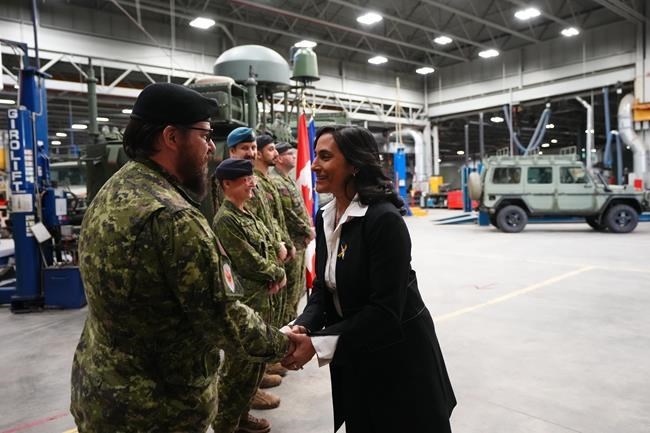OTTAWA — Defence Minister Anita Anand promised to fast-track the purchase of several weapon systems for Canadian soldiers in Europe on Thursday, even as senior commanders painted a stark picture of the numerous other challenges facing the Canada's military.
That included a frank assessment of the military's ongoing personnel crisis, calls for more urgency in upgrading North America's defences and a warning from Canada's top military commander that the country is falling behind its enemies.
"It should be our capabilities keeping adversaries awake at night, but there are capability gaps that I am worried about," chief of the defence staff Gen. Wayne Eyre said. "Our lethality vis-à-vis potential adversaries has decreased in recent years."
The comments came during the Conference of Defence Associations Institute annual conference, where hundreds of Canadian military officers, industry representatives, academics and foreign delegates gather to discuss all things military.
Anand kicked off the conference by praising Ukraine's defence against Russia's invasion last year, while touting the numerous investments that the government is making into Canada's military, including new fighter jets and warships in the coming years.
She also announced plans to address three immediate gaps by expediting the purchase of anti-tank, anti-aircraft and anti-drone weapons for Canadian soldiers guarding against a Russian attack on eastern Europe.
"Canada's largest foreign military deployment, as I'm sure you know, is on NATO's eastern flank in Latvia. And our troops there must have the equipment that they need to protect themselves and to do their jobs, especially at this crucial time."
The weapon systems will be purchased through a mechanism last used during the war in Afghanistan.
Yet even as Anand was plugging those holes in the military, senior Canadian and American commanders were pointing out numerous others across the Canadian Armed Forces.
Among them was Maj.-Gen. Lise Bourgon, who as acting chief of military personnel is responsible for the Armed Forces' human resources. Bourgon revealed that the Armed Forces is short 16,000 service members — far more than previously reported.
And the shortfall is set to worsen, as Bourgon told attendees that the military is failing to meet its recruitment targets by about 25 per cent, while "the rate of attrition is higher than it's ever been."
"These are real, serious risks to mission success," she said. "And this is where the CAF finds itself."
To address the problem, the military has launched a new advertising campaign aimed at getting Canadians into recruiting centres. It also recently opened the doors to permanent residents, all in a drive to get more people into uniform.
But Bourgon admitted in reference to the military's challenge: "We need them a lot more today than they need us."
The commander of Norad was similarly frank in describing the North Warning System, the string of 1980s-era radars in the Far North that forms the backbone of Canada's commitment to North American security, as a "picket fence."
U.S. Gen. Glen VanHerck warned North America's adversaries are growing more dangerous, with China having started mapping the Arctic for submarine operations and North Korea testing nuclear missiles that are capable of hitting the continent.
Those are in addition to the ever-present threat from Russia and Iran's efforts to develop more sophisticated nuclear weapons, as well as the development of new hypersonic and cruise missiles that are hard to detect.
"We can't take a decade to field those capabilities," VanHerck said about upgrading North America's defences. "We need to move faster, with a sense of urgency to make sure that we field them as soon as possible."
Yet VanHerck also revealed he is still waiting for Canada to tell him what the updated Norad system needs to protect, information that will be critical to deciding what the joint U.S.-Canadian command will — and will not — include and do.
"It took me almost two years to get that from the United States. I'm still working with Canada on that," he said, adding it is "really hard to build an operational plan to defend if you don't know what you're actually defending."
Eyre rounded out the discussion by speaking to the Canadian Armed Forces' numerous needs, including new submarines, long-range precision artillery and even ammunition, as western stockpiles have been donated to Ukraine.
The defence chief also flagged what he saw as a lack of military infrastructure in Canada's Arctic, while predicting that the war in Ukraine will "go on for a long time."
This report by The Canadian Press was first published March 9, 2023.
Lee Berthiaume, The Canadian Press




